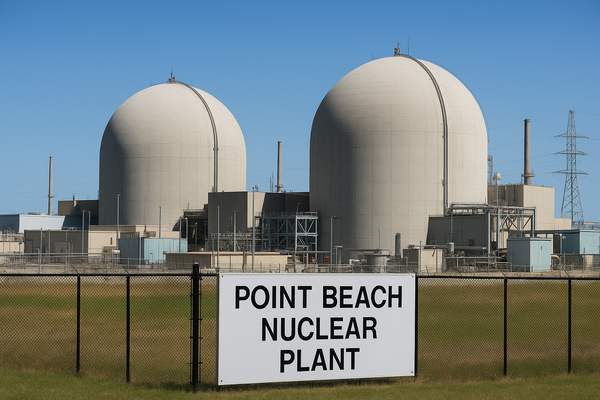
NextEra Energy (NEE) secures NRC renewals for Point Beach Units 1 and 2 through 2050 and 2053. The Nuclear Regulatory Commission’s approval preserves nearly 1 million homes and businesses served by the plant and lands as a reliable, low-carbon baseload source. In the short term, the decision lifted investor sentiment: NEE has climbed 29.8% over the past six months. In the long term, the renewals lock in decades of generation and reduce dispatch risk for customers and large users. Globally, the move echoes other utility investments in firm, low-emission capacity. It matters now because regulators and markets are fast-tracking durability for clean power as demand for reliable capacity rises.
Stock reaction and market signals
NextEra’s (NEE) share performance illustrates how regulatory wins feed market momentum. The stock has surged 29.8% over six months, outpacing peers. Volume spiked in the session following the NRC decision. Exelon (EXC) also drew investor attention: Evercore initiated coverage with an Outperform rating, and EXC has gained 24% year-to-date, including a 2.4% uptick in the most recent session. These quantifiable moves show investors are rewarding firm supply stories. Meanwhile, Constellation Energy (CEG) drew a Seaport Research upgrade to Buy ahead of its pending Calpine acquisition, reinforcing interest in companies pairing stable generation with growth by scale.
Analyst activity, upgrades and the M&A backdrop
Analysts are shifting allocations toward firms that promise dependable output. Seaport’s Buy on Constellation (CEG) cited rising cash flows and the Calpine deal. Evercore’s Outperform on Exelon (EXC) came as institutional buying picked up. Citigroup initiated FirstEnergy (FE) with a Buy, adding another data point of growing sell-side conviction. Across these names, the common thread is upgraded ratings and positive estimate revisions. For Atmos Energy (ATO), consensus earnings estimates have ticked up 0.9% over 90 days and the stock earned a Zacks Rank upgrade. These numbers matter because they translate to flows: upgraded coverage often drives higher trading volumes and tighter bid-ask spreads.
Capital plans, securitization and balance-sheet moves
Investors are watching how utilities fund large projects. American Electric Power (AEP) disclosed issuance of $2 billion in debentures and a West Virginia Public Service Commission approval for $2.4 billion in securitized costs. Those figures matter immediately because they affect near-term interest expense and rating agency assessments. Duke Energy (DUK) is projecting a $190–$200 billion investment program, a multiyear load on capital markets and a driver of long-term rate-base growth. PPL (PPL) has seen its fair value estimate nudge to $38.54 from $38.31 in recent research notes, reflecting how small target moves can reframe valuation conversations. Collectively, these quantified financing steps set the cost of capital that underpins future returns.
Grid projects, data-center capacity and regional capacity wins
Grid modernization and targeted interconnections remain measurable growth vectors. Portland General Electric (POR) and GridCARE completed a first joint project to free up over 80 MW of data-center capacity for 2026, as part of a plan to energize more than 400 MW by 2029. That incremental 80 MW is a concrete near-term boost for load-serving contracts and illustrates how local grid work translates into revenue opportunities. For NextEra (NEE), the Point Beach license adds similarly quantifiable capacity certainty—nearly 1 million customers of service continuity—strengthening utility planning and merchant-contract bargaining positions.
Smaller caps, water utilities and community programs
Smaller and specialized utilities are producing measurable moves too. Global Water Resources (GWRS) jumped 5.2% on higher-than-average trading volume in a recent session, signaling heightened retail and institutional interest. American Water (AWK) reported operational engagement programs: 33 interns participated in its Future Wavemakers program, and Missouri American Water distributed $40,000 in firefighter grants this cycle. Those items quantify workforce development and community investment, which support regulatory goodwill and long-term stability. Investors tracking micro-cap themes can find clear volume and percentage spikes to gauge sentiment.
What these developments mean for investors and markets
Regulatory victories, analyst upgrades and hard-capex commitments are producing measurable market responses. NextEra’s (NEE) 29.8% six-month surge and Exelon’s (EXC) 24% year-to-date gain show how reliability stories convert into price performance. Seaport’s Buy on Constellation (CEG) and Citigroup’s Buy on FirstEnergy (FE) demonstrate how upgraded coverage accompanies M&A and restructuring narratives. Atmos Energy’s (ATO) 0.9% earnings estimate lift and Zacks rank change show how modest estimate revisions can alter perception. These data points feed liquidity and reweight portfolios toward companies with locked-in generation or clear rate-case paths.
However, financing needs remain front and center. AEP’s $2 billion debenture issuance and the $2.4 billion securitization approval represent immediate balance-sheet impacts. Duke’s $190–$200 billion plan underscores the scale of future funding rounds. These are quantifiable pressures that investors and credit analysts will monitor through debt metrics, interest coverage ratios and capital-spend pacing.
In addition, grid projects and targeted capacity releases—like POR’s 80 MW for 2026 and 400 MW through 2029—provide near-term revenue visibility for utilities engaged with large corporate loads. Smaller names such as GWRS are showing that trading volumes and percentage gains can flash early signals of renewed investor appetite.
Overall, the data show a market that is reallocating toward companies that pair regulatory certainty, scale acquisitions and measurable capital plans. The numbers—license renewal dates, percentage gains, issuance sizes, and capacity megawatts—give investors concrete metrics to compare strategies and appetite today versus the recent past.












